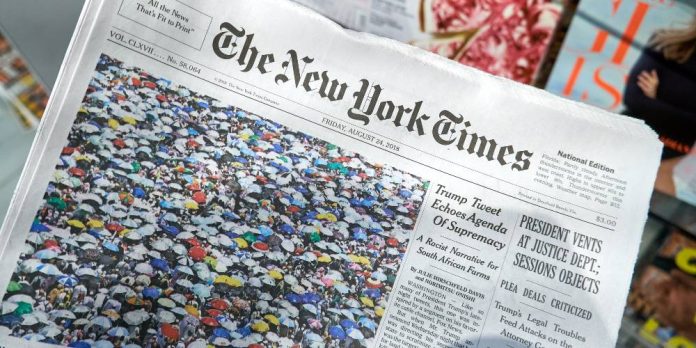After the New York Times published a series of long-form pieces profiling sports betting, the gaming industry responded loudly and proudly that the profiles did not adequately depict how the industry truly works. Kinectify’s Director of Business Development Sean Topchi broke down several assertions made across the stories and provided context and data to debunk and clear up misconceptions from the mainstream media outlet:

The New York Times published a slew of articles earlier this month attacking the gaming industry, which contained numerous baseless and ill-informed arguments. A majority of these arguments centered around how the industry conducts business, responsible gaming, and the negative societal impacts of gaming. As a leader in the gaming community specifically focused on risk management, Kinectify took offense to many of the characterizations and the overall poor research and intentionally deceptive statistics that went into these articles. Here is our rebuttal and assessment.
New York Times Accusation #1:
“The gambling industry managed to scare state lawmakers into keeping tax rates low, in part by trotting out data about a sprawling underworld of illegal gambling. The Times found that those figures, which suggested that Americans were placing as much as $400 billion of illicit bets each year, were unreliable.“
The United Nations Office on Drugs and Crime (UNODC) issued a report on illegal sports betting in December 2021 that supports the claim that this is not just a US issue, but a global problem to the tune of up to $1.7 trillion annually. Even more poignant, UNODC reported a direct link between illegal sports betting and money laundering, stating that “the financial scale of the problem is such that illegal betting is not only a major driver of corruption in sports, but also a major channel for money laundering.”
UNODC further called on government agencies, sports governing bodies, and national and international sports organizations to take a “coordinated approach to tackling these threats.” The global money laundering threat is estimated to reach between $840 billion to $2 trillion and the illegal sports betting market is estimated at up to $1.7 trillion, making this a highly significant issue for all countries and gaming regulators.
Anecdotally, most Americans can attest they have participated in the informal betting economy at least once, if not annually, in fantasy football betting. For years, people have pooled their money and placed bets in various social contexts with fantasy sports and this is only the tip of the iceberg. Bookies are active at most sports games and it’s not difficult to find them and place bets on pretty much any game at any time in US sports.
Using deductive reasoning, the US accounts for 30% of the global gaming sports market, and with the informal global sports betting market estimated at up to $1.7 trillion, this equals up to $500 billion in the US market. Other trends in other informal economies may be illuminating: For example, the cannabis industry existed in the US in an informal or illegal capacity for years before the regulated space was created. After regulation, it took years for sales to significantly increase largely due to the product being used by a smaller segment of society prior to regulation, and normalization with larger segments of the population took some time. Unlike cannabis, sports betting has had near immediate and wide adoption with companies like FanDuel Group and DraftKings Inc. growing quickly into industry titans, indicating that Americans have been betting on sports for years and are comfortable with it.
The New York Times argument that an informal sports betting economy was small and all of a sudden boomed just does not align with reality.
New York Times Accusation #2:
“Few imposed restrictions on companies using promotional offers — such as “risk-free” wagers, in which customers are reimbursed for losing bets — to lure neophyte gamblers. Those tactics have been banned in some countries because of their potential to hook people predisposed to compulsive gambling.“
These types of promotions are commonly known as “free play” in retail casinos and have been around for decades in the industry. Free-play promotions are often geared towards educating users on how to play games and building an audience for certain types of gaming. Gaming companies have concurrently invested in responsible gaming for years, including implementing robust policies and procedures around protecting players with addictive tendencies. Promoting gaming addiction is not good PR for gaming organizations who want to focus on being entertainment companies that encourage healthy habits as opposed to attracting “neophyte gamblers.”
Irresponsible reporting like the New York Times that accuses the industry of harming society damages the industry in numerous ways, including increasing roadblocks to legalization in certain jurisdictions, obtaining and retaining gaming licensing, and reputational damage with reverberations in the financial markets that ultimately may affect the jobs of thousands of Americans working in the gaming industry.
With the proliferation of online gaming, especially around sports betting, there is perhaps an argument to be made to evaluate this type of promotion as well as improvements to responsible gaming practices. This is a much different conversation, however than the one the New York Times put forth that this type of promotion is primarily a tactic to “lure neophyte gamblers.”
New York Times Accusation #3:
“And at the industry’s behest, Kansas lawmakers halved the tax rate on gambling companies’ revenue. Even as Kansans placed $350 million of bets this fall, the state collected less than $271,000 in taxes.“
The New York Times numbers are deceptive and based on poor knowledge of gaming revenue versus wagers. Total wagers are not a revenue number, but rather the total amount of bets placed (handle). Actual adjusted gross revenues in this example amounted to just $2.734 million in a new market with steady growth. The government is positioned to make strong returns over time.
This similar poor reporting occurred in the cannabis industry in the US soon after legalization with many reports claiming state governments were not seeing significant revenues. Many reports targeted California in its early days of cannabis regulation for only earning $300k in the first two quarters, but now three years later the state earns over $1.3 billion annually from the cannabis tax revenue. We anticipate the same trend will hold true in gaming and may even exceed cannabis industry results because sports betting does not hold the same negative stigma as cannabis did and is showing to be much more ubiquitous among the US population, which will be reflected in tax revenues.
The New York Times widely missed the mark in its reporting and repeated a mistake made just years ago in another informal economy that became a legitimate regulated industry.
New York Times Accusation #4:
“They have required few protections for consumers, dedicated minimal funds to combating addiction and often turned to the gambling industry to help shape regulations and police its own compliance with them, a New York Times investigation found. Unlike some countries that have endured waves of gambling addiction, few states have imposed restrictions on the kinds of promotions that helped hook Mr. Hummel.“
Responsible gaming has been important to the industry for years. Many gaming organizations have robust responsible gaming programs and even include in-depth training for all staff at onboarding, ongoing training annually, and specific procedures to help identify and protect players with addictive behaviors. Gaming organizations are greatly incentivized to make this a focus to protect their gaming licenses, promote expansion of the regulated industry, and avoid reputational damage.
More than $300 million is invested in the industry annually to support responsible gaming programs, with three-quarters coming directly from gaming companies, and the remainder allocated from gaming tax revenue. The American Gaming Association (AGA) has focused on responsible gaming for years and has published a Code of Conduct that includes commitments from nearly all major operators.
Additionally, many influential tribes have focused intensively on responsible gaming with the San Manuel Band of Mission Indians partnering with UNLV and UCLA on research to develop “next generation” responsible gaming best practices.
The New York Times made vague statements about the lack of consumer protections and funding but did not properly research industry practices and the strong commitments already in place that augment regulation and tax revenue. The best solutions are often public-private partnerships, and the gaming industry has been engaged in this in a robust way for years to promote responsible gaming.
New York Times Accusation #5:
”Representative John Barker, a cattle breeder, retired judge and chairman of one of the most powerful committees in the Kansas legislature, had a glass of 30-year Redbreast Irish whiskey in his hand and a Don Tomas cigar from Honduras in his mouth.“
Casino lobbying in the US does not even break into the top 20 in terms of money spent. The largest gaming spenders in 2022 only approached $2.5m, compared to the top 20 which are in the $9m to $59m range. If the New York Times wants to attack lobbying practices, maybe they should turn their attention to the US Department of Commerce at $59 million or Meta at $15 million, as opposed to the gaming industry’s largest spender, Gila River Indian Community, at $2.5m.
Painting a picture of a retired Judge from Kansas drinking a whiskey and smoking a cigar does no justice to the professional gaming industry that operates in the light of day, is highly regulated, and does not even scratch the surface of big-dollar lobbying efforts practiced by most other industries.
The New York Times engaged in unprofessional, poorly researched, and sensationalized coverage of a very common practice for most industries.
New York Times Accusation #6
And when the University of Colorado Boulder in 2020 accepted $1.6 million to promote sports gambling on campus, a betting company sweetened the deal by offering the school an extra $30 every time someone downloaded the company’s app and used a promotional code to place a bet.
Members of the American Gaming Association (AGA) do not engage in these promotional practices. This includes most top gaming organizations in the sports betting space such as MGM Resorts International, Seminole Hard Rock Gaming, Choctaw Nation, Fanduel Group, Draftkings Inc., PENN Entertainment, Bally’s Corporation, Churchill Downs, The Cordish Companies, Las Vegas Sands, and Entain PLC.
We do not dispute the unsavory example given in the New York Times article and the potential need for additional regulation in this area, but this should not characterize normal practices in the industry as the article implies. Every member of the AGA has signed a commitment to not engage in this practice.
While we appreciate the New York Times’ efforts to cover the industry, we are disappointed in the lack of professionalism and research that went into its coverage. The gaming industry is highly regulated, provides significant revenues back to the communities in which these companies operate, and is a significant employer for thousands of Americans. All we ask is for more balanced coverage with data that is accurately reflected.













